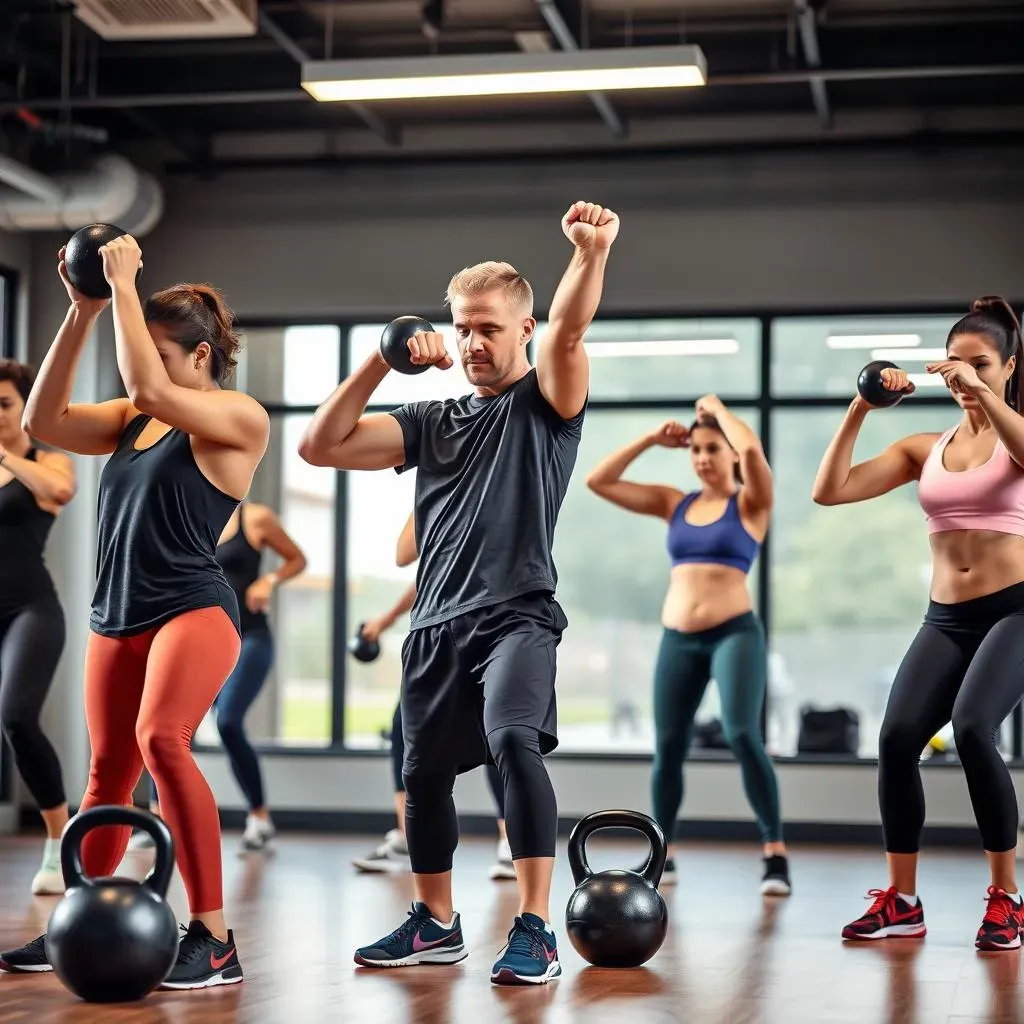Table of Contents
Ready to torch calories, build serious strength, and boost your endurance, all with one simple tool? A full body workout with a kettlebell might just be the game-changer you've been searching for. This isn't your average workout; it's a dynamic, total-body experience that engages multiple muscle groups simultaneously, delivering maximum results in minimal time. Forget endless hours on the treadmill or isolating individual muscles with machines. We're talking functional fitness that translates directly into real-world strength and power.
Why Choose a Full Body Workout with a Kettlebell?

Why Choose a Full Body Workout with a Kettlebell?
so you're wondering, "Why choose a full body workout with a kettlebell?" Let me tell you, it's not just a workout; it's a total game-changer. Think about it: how often do you get to combine strength, cardio, and flexibility all in one go? Kettlebells make it possible. Unlike isolating exercises on machines, kettlebell movements are compound, meaning they engage multiple muscle groups at once. This skyrockets your calorie burn, builds functional strength that translates to everyday life, and improves your overall athleticism. It's like hitting the fast-forward button on your fitness goals.
Plus, let's be real, who has endless hours to spend at the gym? Kettlebells are efficient. You can get a killer workout in just 30 minutes, making it perfect for busy schedules. And the variety? Endless. From swings and squats to presses and rows, the possibilities are truly limitless. It keeps things interesting, so you're less likely to get bored and ditch your routine. Seriously, boredom is the enemy of progress, and kettlebells are the antidote.
Benefit | Description |
|---|---|
Full-Body Engagement | Works multiple muscle groups simultaneously for maximum efficiency. |
Cardio and Strength | Combines aerobic and resistance training for a complete workout. |
Functional Fitness | Builds strength that translates to real-world activities. |
Time-Efficient | Provides a challenging workout in a short amount of time. |
Variety | Offers a wide range of exercises to keep workouts engaging. |
I remember when I first started using kettlebells. I was skeptical, honestly. I thought they were just another fitness fad. But after my first workout, I was hooked. I felt muscles I didn't even know I had! And the best part? I wasn't stuck on a machine, mindlessly repeating the same movement. I was moving my body in new and challenging ways, feeling stronger and more powerful with every swing. Trust me, once you experience the benefits of a full body workout with a kettlebell, you'll never look back.
Essential Kettlebell Exercises for a Full Body Workout

Essential Kettlebell Exercises for a Full Body Workout
Kettlebell Swings: The King of Kettlebell Exercises
If there's one exercise that screams "kettlebell," it's the swing. Seriously, this move is the cornerstone of any solid full body workout with a kettlebell. It's not just about flailing your arms; it's a powerful hip hinge movement that engages your glutes, hamstrings, core, and even your shoulders. Think of it as a dynamic plank that builds explosive power and torches calories. The swing teaches you how to generate force from your hips, which is crucial for athletic performance and everyday movements.
To do it right, start with the kettlebell a few inches in front of you. Hinge at your hips, keeping your back straight, and grab the kettlebell with both hands. Hike the kettlebell back between your legs, then explosively drive your hips forward, swinging the kettlebell up to chest height. Squeeze your glutes at the top and let the kettlebell swing back down, repeating the movement. Remember, it's a hip hinge, not a squat! Focus on using your hips to power the swing, not your arms. And keep your core engaged throughout the entire movement to protect your lower back.
Goblet Squats: Master Your Squat Form
Squats are a fundamental movement for building lower body strength, and the goblet squat is a fantastic variation for kettlebell training. Holding the kettlebell close to your chest in a "goblet" position not only improves your squat form but also engages your core and upper back. This exercise is perfect for beginners because it helps you maintain an upright posture and prevents you from leaning forward, which is a common mistake in traditional squats.
To perform a goblet squat, hold the kettlebell by the horns close to your chest. Stand with your feet slightly wider than shoulder-width apart, toes pointed slightly outward. Keeping your back straight and your core engaged, lower yourself down into a squat, as if you're sitting back into a chair. Aim to get your thighs parallel to the ground or lower, if possible. Pause at the bottom, then push through your heels to return to the starting position. Focus on maintaining good form throughout the entire movement, and don't let your knees cave inward.
Kettlebell Clean and Press: The Ultimate Full-Body Integrator
The kettlebell clean and press is a true test of full-body strength and coordination. This complex movement combines a clean, which brings the kettlebell from the ground to a racked position at your shoulder, with a press, which pushes the kettlebell overhead. It engages your legs, core, back, shoulders, and arms, making it an incredibly efficient exercise for building overall strength and power. It’s a staple in any serious full body workout with a kettlebell.
Start with the kettlebell on the ground in front of you. Hinge at your hips and grab the kettlebell with one hand. In one fluid motion, pull the kettlebell up, flipping it around your wrist and catching it in the racked position at your shoulder. From there, press the kettlebell overhead, extending your arm fully. Lower the kettlebell back to the racked position, then back down to the ground. Repeat the movement on the other side. Focus on using your legs and hips to generate power for the clean and press, and keep your core engaged throughout the entire movement to maintain stability.
Exercise | Primary Muscles Worked | Benefits |
|---|---|---|
Kettlebell Swings | Glutes, Hamstrings, Core | Builds explosive power, improves cardio |
Goblet Squats | Quads, Glutes, Core | Improves squat form, engages core |
Kettlebell Clean and Press | Full Body | Builds overall strength and coordination |
The Ultimate Full Body Kettlebell Workout Routine

The Ultimate Full Body Kettlebell Workout Routine
Warm-Up: Preparing Your Body for Action
Before diving into the ultimate full body kettlebell workout routine, it's crucial to prime your body with a proper warm-up. Think of it like gently coaxing your muscles awake, increasing blood flow, and lubricating your joints. A dynamic warm-up, focusing on movements that mimic the exercises you'll be performing, is ideal. This not only reduces your risk of injury but also enhances your performance by improving mobility and flexibility. Don't skip this step; it's an investment in your long-term fitness.
A great warm-up routine could include arm circles, leg swings, torso twists, and some light cardio like jumping jacks or high knees. Spend about 5-10 minutes on your warm-up, focusing on controlled movements and feeling your body loosen up. You can even incorporate some light kettlebell movements, such as kettlebell halos or light swings, to get your muscles firing and your mind focused. Remember, the goal is to prepare your body for the workout ahead, not to exhaust yourself before you even begin.
- Arm Circles (forward and backward): 10 reps each direction
- Leg Swings (forward and sideways): 10 reps each leg
- Torso Twists: 10 reps each side
- Jumping Jacks: 20 reps
- High Knees: 20 reps
The Workout: Combining Strength and Power
Now for the main event: the ultimate full body kettlebell workout routine! This routine is designed to hit every major muscle group, combining strength exercises with power movements to maximize your results. We'll be using a circuit format, performing each exercise for a set number of reps or time, with minimal rest in between. This keeps your heart rate elevated, turning your workout into a cardio session as well. Remember to focus on proper form and technique throughout the entire workout, and don't be afraid to modify exercises to suit your fitness level.
Here's a sample routine you can follow: Kettlebell Swings (15 reps), Goblet Squats (10 reps), Kettlebell Clean and Press (5 reps per side), Kettlebell Rows (10 reps per side), and Kettlebell Russian Twists (15 reps per side). Perform each exercise back-to-back with minimal rest, then rest for 1-2 minutes after completing the entire circuit. Repeat the circuit 3-4 times, depending on your fitness level. As you get stronger, you can increase the number of reps, sets, or the weight of the kettlebell to continue challenging yourself.
Exercise | Reps | Sets | Rest |
|---|---|---|---|
Kettlebell Swings | 15 | 3-4 | Minimal |
Goblet Squats | 10 | 3-4 | Minimal |
Kettlebell Clean and Press | 5 (per side) | 3-4 | Minimal |
Kettlebell Rows | 10 (per side) | 3-4 | Minimal |
Kettlebell Russian Twists | 15 (per side) | 3-4 | 1-2 minutes after the circuit |
Full Body Kettlebell Workout: Modifications for All Fitness Levels

Full Body Kettlebell Workout: Modifications for All Fitness Levels
Scaling for Beginners: Mastering the Basics
So, you're eager to jump into a full body kettlebell workout, but you're just starting out? No sweat! The beauty of kettlebells is that they're incredibly adaptable. The key is to focus on mastering the fundamental movements before you start throwing around heavy weight. That means prioritizing proper form and technique over lifting the heaviest kettlebell in the gym. Start with lighter weights, even if it feels too easy at first. It's better to build a solid foundation than to risk injury by going too hard, too soon.
Think about it like learning to play an instrument. You wouldn't start with a complex concerto; you'd begin with basic scales and chords. The same principle applies to kettlebell training. Master the kettlebell swing, goblet squat, and other essential exercises with lighter weights until you feel confident in your form. As you get stronger and more comfortable, you can gradually increase the weight. Remember, consistency and proper technique are the keys to long-term success.
Progressing for Advanced Lifters: Level Up Your Training
Alright, you've been swinging kettlebells for a while now, and you're ready to take your training to the next level. Awesome! To keep seeing progress, you need to continually challenge your body. This means increasing the weight, adding more reps or sets, or incorporating more complex exercises. Don't get stuck in a rut doing the same routine week after week. Your body will adapt, and you'll plateau. It’s time to push yourself and explore new variations to keep your muscles guessing.
Consider adding advanced kettlebell exercises like snatches, Turkish get-ups, or double kettlebell movements to your routine. These exercises require a higher level of skill and coordination, but they'll challenge your strength, power, and stability in new ways. You can also experiment with different training protocols, such as density training or complexes, to increase the intensity of your workouts. Just remember to listen to your body and progress gradually to avoid injury. And don't be afraid to seek guidance from a qualified kettlebell instructor to ensure you're performing these advanced movements correctly.
Modifying for Injuries and Limitations: Listen to Your Body
We all have our limitations, whether it's a nagging injury or a specific physical condition. The good news is that you can still enjoy the benefits of a full body kettlebell workout by making appropriate modifications. The key is to listen to your body and avoid any movements that cause pain or discomfort. Don't try to push through pain; it's a sign that something isn't right. Instead, focus on finding alternative exercises or modifying existing ones to accommodate your limitations.
For example, if you have lower back pain, you might need to modify the kettlebell swing or avoid it altogether. You could try substituting it with glute bridges or hip thrusts to strengthen your glutes and hamstrings without putting as much stress on your lower back. Similarly, if you have shoulder issues, you might need to modify the kettlebell clean and press or choose a different overhead exercise. The goal is to find exercises that you can perform safely and effectively while still challenging your body. And always consult with a healthcare professional or certified personal trainer to get personalized advice on how to modify your workouts to suit your specific needs.
Limitation | Modification |
|---|---|
Lower Back Pain | Substitute swings with glute bridges or hip thrusts |
Shoulder Issues | Modify clean and press or choose alternative overhead exercise |
Knee Pain | Reduce squat depth or use a box to squat to |
Maximize Your Full Body Workout with a Kettlebell: Tips and Techniques

Maximize Your Full Body Workout with a Kettlebell: Tips and Techniques
Perfect Your Form: Quality Over Quantity
Alright, let's talk about taking your kettlebell game to the next level. You want to maximize your full body workout with a kettlebell, right? It all starts with form. I can't stress this enough: perfect your form before you even think about adding weight or reps. Seriously, sloppy form is a recipe for injury, and nobody wants that. Think of each rep as a practice session, focusing on controlled movements and proper technique. Watch videos, ask a trainer for feedback, and record yourself to identify areas for improvement. It might seem tedious at first, but trust me, it'll pay off in the long run. You'll not only avoid injuries but also get more out of each and every rep.
One of the best ways to improve your form is to break down each exercise into its individual components. For example, with the kettlebell swing, focus on the hip hinge, the glute squeeze, and the core engagement separately before putting it all together. This helps you develop a better understanding of the movement and ensures that you're using the right muscles. And don't be afraid to start with lighter weights or even no weight at all while you're perfecting your form. Remember, it's a marathon, not a sprint. The goal is to build a solid foundation of strength and technique that will allow you to progress safely and effectively over time.
Embrace Progressive Overload: Keep Challenging Yourself
so you've mastered your form, and you're feeling strong and confident. Now what? It's time to embrace progressive overload! This is the principle of gradually increasing the demands on your body over time to continue seeing progress. It's like climbing a ladder, each step representing a new challenge that pushes you closer to your goals. Without progressive overload, your body will adapt to the workload, and you'll plateau. It's a sure-fire way to keep your muscles growing and your strength increasing.
There are several ways to implement progressive overload in your full body workout with a kettlebell. You can increase the weight of the kettlebell, add more reps or sets, decrease the rest time between sets, or even try more challenging variations of exercises. For example, if you're comfortable with the goblet squat, you could try a front squat or even an overhead squat to increase the difficulty. Or, if you're doing kettlebell swings, you could try increasing the weight or adding a band around your legs to increase the glute activation. The key is to find ways to continually challenge yourself without sacrificing proper form. And remember, progress isn't always linear. There will be times when you feel like you're not getting stronger, but don't get discouraged. Just keep showing up, keep pushing yourself, and trust the process.
Method | Description | Example |
|---|---|---|
Increase Weight | Use a heavier kettlebell | Go from a 16kg to a 20kg kettlebell |
Increase Reps | Perform more repetitions per set | Increase from 10 to 12 reps per set |
Increase Sets | Perform more sets of each exercise | Increase from 3 to 4 sets |
Decrease Rest | Reduce the rest time between sets | Reduce rest from 60 seconds to 45 seconds |
Increase Difficulty | Try more challenging exercise variations | Progress from goblet squats to front squats |
Elevate Your Fitness Journey with a Full Body Workout with a Kettlebell
Incorporating a full body workout with a kettlebell into your fitness regime can be a transformative experience. From building explosive power and enhancing muscular endurance to improving your overall functional fitness, the benefits are undeniable. Remember to prioritize proper form, listen to your body, and gradually increase the intensity as you progress. With dedication and consistency, you'll not only achieve your fitness goals but also discover a newfound appreciation for the versatility and effectiveness of kettlebell training. So, pick up that kettlebell and start forging a stronger, fitter, and more resilient you today!